
In heraldry, the Allocamelus (a.k.a. Ass-Camel) was the depiction of a mythical creature with the head of a donkey and the body of a camel. It was first used as a crest for the English Eastland Company, and later by the Russia Company.

In heraldry, the Allocamelus (a.k.a. Ass-Camel) was the depiction of a mythical creature with the head of a donkey and the body of a camel. It was first used as a crest for the English Eastland Company, and later by the Russia Company.

A camel is an even-toed ungulate in the genus Camelus that bears distinctive fatty deposits known as "humps" on its back. Camels have long been domesticated and, as livestock, they provide food and textiles. Camels are working animals especially suited to their desert habitat and are a vital means of transport for passengers and cargo. There are three surviving species of camel. The one-humped dromedary makes up 94% of the world's camel population, and the two-humped Bactrian camel makes up 6%. The Wild Bactrian camel is a separate species and is now critically endangered.
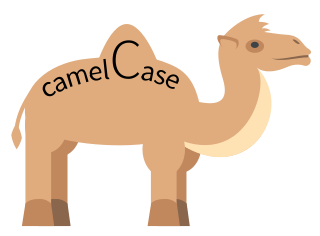
Camel case is the practice of writing phrases without spaces or punctuation. The format indicates the separation of words with a single capitalized letter, and the first word starting with either case. Common examples include ""YouTube", "iPhone" and "eBay". It is also sometimes used in online usernames such as "johnSmith", and to make multi-word domain names more legible, for example in promoting "EasyWidgetCompany.com".

Heraldry is a discipline relating to the design, display and study of armorial bearings, as well as related disciplines, such as vexillology, together with the study of ceremony, rank and pedigree. Armory, the best-known branch of heraldry, concerns the design and transmission of the heraldic achievement. The achievement, or armorial bearings usually includes a coat of arms on a shield, helmet and crest, together with any accompanying devices, such as supporters, badges, heraldic banners and mottoes.

A coat of arms is a heraldic visual design on an escutcheon, surcoat, or tabard. The coat of arms on an escutcheon forms the central element of the full heraldic achievement, which in its whole consists of a shield, supporters, a crest, and a motto. A coat of arms is traditionally unique to the armiger. The term itself of 'coat of arms' describing in modern times just the heraldic design, originates from the description of the entire medieval chainmail 'surcoat' garment used in combat or preparation for the latter.
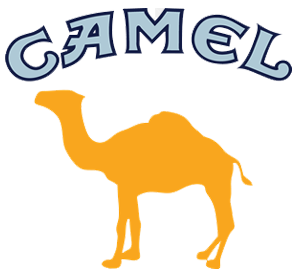
Camel is an American brand of cigarettes, currently owned and manufactured by the R. J. Reynolds Tobacco Company in the United States and by Japan Tobacco outside the U.S.
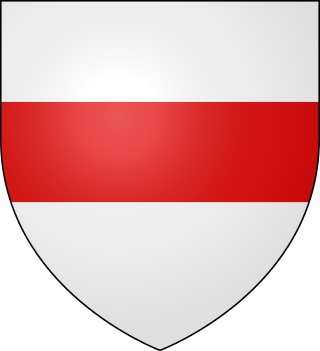
In heraldry, a fess or fesse is a charge on a coat of arms that takes the form of a band running horizontally across the centre of the shield. Writers disagree in how much of the shield's surface is to be covered by a fess or other ordinary, ranging from one-fifth to one-third. The Oxford Guide to Heraldry states that earlier writers including Leigh, Holme, and Guillim favour one-third, while later writers such as Edmondson favour one-fifth "on the grounds that a bend, pale, or chevron occupying one-third of the field makes the coat look clumsy and disagreeable." A fess is likely to be shown narrower if it is uncharged, that is, if it does not have other charges placed on it, and/or if it is to be shown with charges above and below it; and shown wider if charged. The fess or bar, termed fasce in French heraldry, should not be confused with fasces.
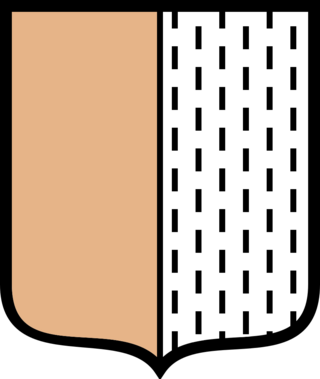
In heraldry, carnation is a tincture, the name for skin colour, more exactly the colour of pale or white human skin.
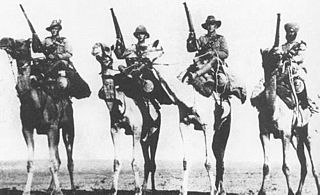
The Imperial Camel Corps Brigade (ICCB) was a camel-mounted infantry brigade that the British Empire raised in December 1916 during the First World War for service in the Middle East.

The griffin, griffon, or gryphon is a legendary creature with the body, tail, and back legs of a lion; the head and wings of an eagle; and sometimes an eagle's talons as its front feet. Because the lion was traditionally considered the king of the beasts, and the eagle the king of the birds, by the Middle Ages, the griffin was thought to be an especially powerful and majestic creature. Since classical antiquity, griffins were known for guarding treasures and priceless possessions.

In heraldry and heraldic vexillology, a blazon is a formal description of a coat of arms, flag or similar emblem, from which the reader can reconstruct the appropriate image. The verb to blazon means to create such a description. The visual depiction of a coat of arms or flag has traditionally had considerable latitude in design, but a verbal blazon specifies the essentially distinctive elements. A coat of arms or flag is therefore primarily defined not by a picture but rather by the wording of its blazon. Blazon is also the specialized language in which a blazon is written, and, as a verb, the act of writing such a description. Blazonry is the art, craft or practice of creating a blazon. The language employed in blazonry has its own vocabulary, grammar and syntax, which becomes essential for comprehension when blazoning a complex coat of arms.

Canadian heraldry is the cultural tradition and style of coats of arms and other heraldic achievements in both modern and historic Canada. It includes national, provincial, and civic arms, noble and personal arms, ecclesiastical heraldry, heraldic displays as corporate logos, and Canadian blazonry.

In the United States Army, tabs are cloth and/or metal arches displaying a word or words signifying a special skill that are worn on U.S. Army uniforms. On the Army Combat Uniform and Army Service Uniform, the tabs are worn above a unit's Shoulder Sleeve Insignia (SSI) and are used to identify a unit's or a soldier's special skill(s) or are worn as part of a unit's SSI as part of its unique heritage. Individual tabs are also worn as small metal arches above or below medals or ribbons on dress uniforms.
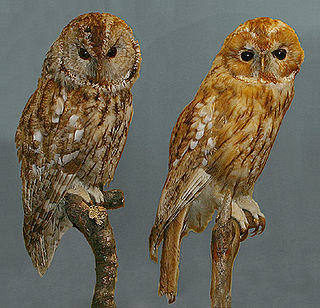
Tawny is a light brown to brownish-orange color.

The national emblem of Eritrea was adopted on 24 May 1993 on the occasion of Eritrea's declaration of independence from Ethiopia. The emblem mainly depicts a camel surrounded by an olive wreath.

Erasure in blazon, the language of heraldry, is the tearing off of part of a charge, leaving a jagged edge of it remaining. In blazons the term is most often found in its adjectival form, erased, and is usually applied to animate charges, most often heads or other body parts.

Kneeling Camels is a public art work by Paul Moulon located at front entrance of the Tripoli Shrine Temple, a civic organization in the Concordia neighborhood west of downtown Milwaukee, Wisconsin. The work consists of two large camels carved from stone. The two sculptures were installed in 1928 at a cost of $10,000.
CamelPhat are an English DJ and production duo, consisting of Dave Whelan and Mike Di Scala, formed in Liverpool in 2004. They are best known for the 2017 single "Cola", which peaked at number 3 in the UK Dance Chart, and at number 18 in the UK Singles Chart. The single was a collaboration with UK dance act Elderbrook and was released on Defected Records.

Heraldic badges of the Royal Air Force are the insignia of certain commands, squadrons, units, wings, groups, branches and stations within the Royal Air Force. They are also commonly known as crests, especially by serving members of the Royal Air Force, but officially they are badges. Each badge must be approved by the reigning monarch of the time, and as such will either have a King's or Queen's Crown upon the top of the badge, dependent upon which monarch granted approval and the disbandment date of the unit. The approval process involves a member of the College of Arms who acts as an advisory on all matters pertaining to the design and suitability of the insignia and motto.